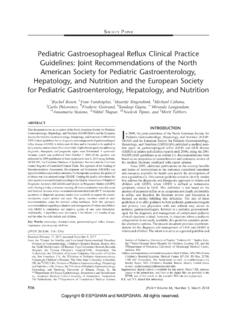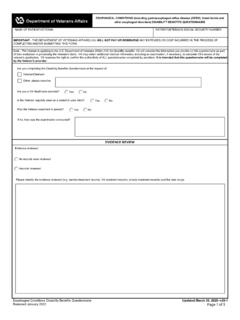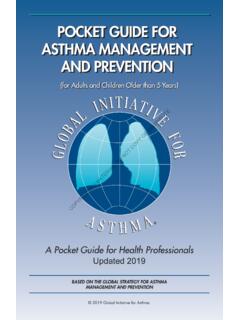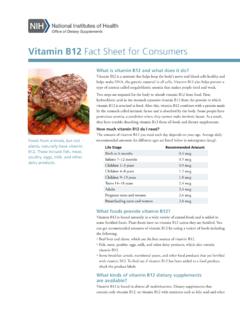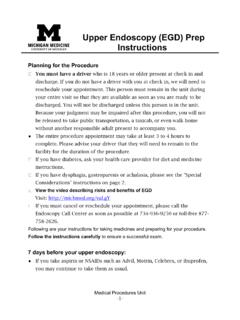Transcription of Infant/Children PPI dosing information
1 gastroesophageal REFLUX IS A COMMON PROBLEM THAT AFFECTS most infants in the first year of life. It often manifests as vomiting or spitting up, and usually resolves by the first birthday.(1,2,3) gastroesophageal reflux disease (GERD) in infants is less common but more serious conditions or that can be associated with recurrent vomiting, painful swallowing, feeding problems, poor weight gain, persistent irritability, abdominal pain, and esophagitis.(2,3) Less commonly, GERD has been associated with apparent life-threatening events and chronic respiratory disorders.(2) A decrease in lower esophageal sphincter tone is the primary contributing factor to GERD in infants. Treatment is aimed at decreasing symptoms, as well as the frequency and duration of reflux episodes; healing the injured mucosa; and preventing complications.(1) Portions of this document have been excerpted from: Ellen Fan, BScPhm; Scott Gavura, BScPhm, MBA; Brent Ruddock, BScPhm.
2 Focus On Patient Care. Proton Pump Inhibitors in Pediatric Patients. CPJ/RPC September/October 2006, Vol 139, No is difficult to clinically define optimal doses of PPIs in pediatric patients due to limitations in the design of studies that have been conducted to date. For omeprazole, evidence-based guidelines recommend a dose of 1 mg/kg/day, either as a single dose or divided twice daily.(2) However, this dose of omeprazole (1 mg/kg/day) was shown to not differ from placebo in infants with GERD. Similar doses, given once daily with other PPIs (pantoprazole, lansoprazole, esomeprazole) also failed to be different than placebo in infants with GERD. In other clinical trials, doses of omeprazole ranging to mg/kg/day (maximum 80 mg; age range of 3 weeks to 18 years) have been successfully used.(4) Two studies by Phillips JO, et al (5,6) have found that infants and young children who fail to respond to the 1 mg/kg/day dosage regimen, will respond to to per kg per dose, with three doses per day being given (approximately 90% of infants and young children responded).
3 Data from Tommy Andersson, clinical pharmacologist and director of research for this particular study done for Astra Zeneca (the makers of Prilosec and Nexium ), Andersson et al (7), showed that larger doses of PPI are needed in children. He states, Infant/Children PPI dosing information The doses of omeprazole required were substantially higher doses per kilogram of body weight than in adults. He goes on to state that, The pharmacokinetics of omeprazole in children showed a trend toward higher metabolic capacity with decreasing age, being highest at 1-6 yr of age. This may explain the need for higher doses of omeprazole on a per kilogram basis, not only in children overall compared with adults but, in many cases, particularly in younger children. Further, data from Catherine Litalien, Department of Pediatric Nephrology CHU, Litalien et al (8), support that higher mg/kg doses are required in children.
4 Litalien states: PPIs are rapidly metabolized in children. Then goes on to say, the absolute bioavailability of omeprazole increases with repeated dosing in children. And A higher metabolic capacity in children as well as differences in the extent of PPI bioavailability are most likely responsible for this finding. This may partly account for the need in children for variable and sometimes considerably greater doses of PPIs, on a per kilogram basis, than for adults to achieve similar plasma concentrations. In general, as with all medications, one should consider the risks to benefits of using a PPI for infants with GERD and you should always consult your doctor when making your decision regarding the use of PPI s for your child with Infant acid reflux. Of course there should be symptoms consistent with acid reflux present. If a lower dose of the PPI does not work, then studies have suggested going to a higher dose for a two week to a four week trial is reasonable.
5 In these infants using just a little bit more is not likely to do much. Based upon the observations that infants and young children metabolize the PPIs much faster than adults, it is reasonable to use to per kg per dose, three doses per PPIsPPIs are, by their nature, subject to destruction by stomach acid. This is called acid lability. That is why the PPIs are available as enterically coated beads, tablets or suspensions that contain enterically coated beads. Zegerid is available as an uncoated suspension in buffer (both capsules and powder for oral suspension). When a PPI is compounded into a suspension by a pharmacist, the enteric coating is removed. This means that the buffer used in the compound must be sufficient to neutralize the stomach acid so that the PPI can be absorbed. So the question is how much buffer is required per each dose. This will depend on the strength of the buffer and the age of the infant or child with acid reflux.
6 In a review by Fan E, et al. entitled, Proton pump inhibitors in pediatric patients, the authors suggest a minimum volume of antacid (buffer) that should be used per dose and is dependent upon age. (11) The Hospital for Sick Children. Parent Med-Aid: omeprazole. Toronto: The Hospital for Sick Children; JO et al (5,6) has used sodium bicarbonate, calcium carbonate or magnesium hydroxide as suitable buffers in infants and young children. Typically, for very young infants of one to four months a minimum volume should be approximately 3mL per dose to provide suitable buffering capacity. 1 Sandritter T. gastroesophageal reflux disease in infants and children. J Pediatr Health Care 2003;17(4) Rudolph CD, Mazur LJ, Liptak GS, et al. Guidelines for evaluation and treatment of gastroe- sophageal reflux in infants and children: recommendations of the North American Society for Pediatric Gastroenterology and Nutrition.
7 J Pediatr Gastroenterol Nutr 2001;32 Suppl 2 Jung AD. gastroesophageal reflux in infants and children. Am Fam Physician 2001; 64(11): Gibbons TE, Gold BD. The use of proton pump inhibitors in children: a comprehensive review. Paediatr Drugs 2003;5(1) Phillips JO, Bettag ME, Parsons DS, Wilder B, Metzler MH. Use of flavored lansoprazole or omeprazole suspension in pediatric GERD. Gastroenterol 2000; 118: Phillips JO, Parsons DS, Fitts SW. Flavored lansoprazole suspension in pediatric GERD. J Ped Gastro and Nutrition. 2000; 31: Andersson T, Hassall E, Lundborg P, et al. Pharmacokinetics of orally administered omeprazole in children.. Am J Gastroenterol 2000; 95: Litalien C, Theoret Y, Faure C. Pharmacokinetics of proton pump inhibitors in children. Clin Pharmacokinetics 2005; 44: 441-466.
